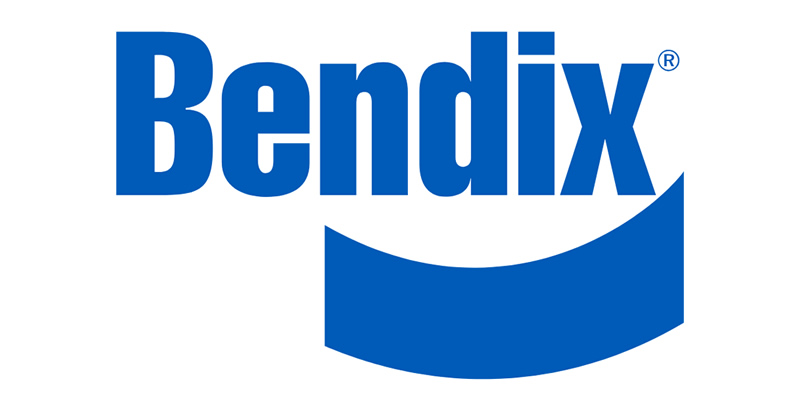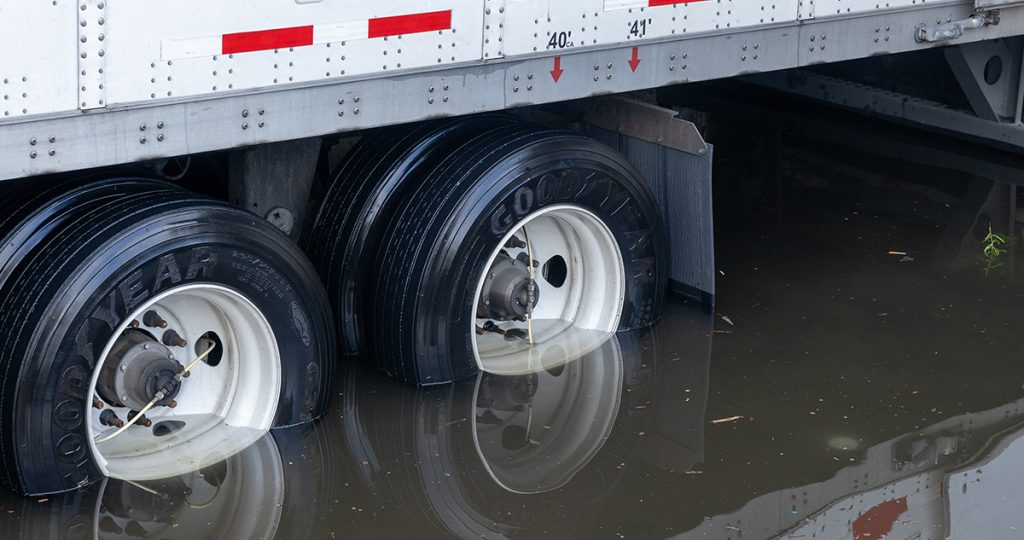Home » Trailer Industry » Trailer Industry News » Inspecting Trailer Air Brake & Wheel Ends Post-Flood

BENDIX TECH TIPS: POST FLOOD INSPECTION AND RECONDITIONING ADVICE FOR TRACTORS AND TRAILERS
Thorough Checks and Testing Are Crucial to Getting Vehicles Safely Back on the Road
AVON, Ohio – (Trailer Technician) – Hurricanes and summer storms are once again unleashing torrential rain in regions of the United States, resulting in devasting floods requiring massive relief and rebuilding efforts – many of which depend on the trucking industry and thousands of truck drivers. For commercial vehicles exposed to these types of floodwaters, this special installment of the Bendix Commercial Vehicle Systems LLC (Bendix) Tech Tips series provides fleets and drivers with technical advice on inspecting and possibly reconditioning air brake, wheel-end, and other safety components that have been partially or completely submerged.
“One important thing to note is that electric vehicles (EVs) are becoming more common, and service procedures for EVs require special training,” said Randy Salvatora, engineering manager – Vehicle Systems at Bendix. “Do not approach a previously submerged hybrid or electric vehicle until the high-voltage electrical system is inspected by a qualified technician.”

Salt Water vs. Fresh
The first determination to make is whether the water affecting the vehicle was salt water or fresh water. If it was salt water, you’ll need to immediately begin replacing parts due to its extreme corrosivity, which can remove lubrication and put certain parts at much higher risk for unexpected and premature malfunction. Any brake system valve that has been submerged in salt water must be replaced. In addition, systems and components including air compressors, air reservoirs, antilock brake system (ABS) relays, modulators, wiring harnesses, and brake actuators must also be replaced. Talk to your Bendix account manager or call the Bendix Tech Team for complete details.
“Saltwater corrosion is also a threat to brake mechanisms, since it increases the likelihood of rust jacking of the friction material and accelerates corrosion of critical surfaces,” Salvatora said. “So, we recommend complete replacement of the foundation brakes to prevent a potential future failure. And if it’s not clear whether the water was fresh or salt, play it safe and follow the saltwater guidelines.”
Additionally, when replacing any pneumatic system components that have been subjected to flood conditions, disconnect all contaminated air tubes and hoses, flush them with clean water, and blow them out with air pressure to remove contaminants.
Fresh-Water Damage Guidelines
If you’re certain the power unit or trailer was submerged in fresh water, begin by carefully power-washing the vehicle – including the foundation brakes. Be cautious while cleaning: Rubber parts and sealing interfaces should not be directly sprayed with the high-pressure jet. Irreparable damage to valves will occur when a high-pressure washer directly sprays exhaust ports. Appropriate PPE (Personal Protective Equipment) is recommended while washing or working on flooded vehicles, whether salt water or fresh. In the unapplied state, most valves have the delivery open to atmosphere at the exhaust port, so if any exhaust port is submerged, the water has infiltrated the system and can lead to future malfunction.
Do not attempt to start a vehicle if fresh water has entered the air compressor or dryer through the air system intakes. Follow these steps to thoroughly check the various parts of the air brake system:
Vehicle valving
- Inspect each component in the pneumatic brake and accessory systems.
- Drain any pressure remaining in the service reservoirs.
- Mark and remove all pneumatic and electrical connectors at each valve.
- Check for evidence of water or contamination inside the connectors, air hoses, or the component itself.
- Carefully inspect any wiring harness connections. Water infiltration at the connector can lead to corrosion of the wiring harness inside the insulation. This can lead to intermittent continuity, increased resistance, and time-consuming electronic diagnostics.
- Carefully use dry compressed air pressure (from a stationary compressor or similar) to blow air through the pneumatic tubes and hoses. Watch for evidence of water or contamination.
- If water or contamination is found inside the component, replace the component.
- If no evidence of water or contamination is found inside the component, reassemble the component to the associated lines and fittings.
- Repeat this process as you continue to inspect all the valves in the air brake system. Replace any nonfunctioning valves or those showing evidence of ingestion of water or contaminants.
- Inspect tractor and trailer glad hands and the supply and control hoses. Water and contaminants frequently enter the air brake system through unprotected glad hands.
Charging system
- Inspect the air intake, compressor, and air dryer for signs of water or contaminant ingestion.
- Carefully use dry compressed air pressure (from a stationary compressor or similar) to blow air through the pneumatic tubing and watch for evidence of water or contamination.
- An electrically driven air compressor that has been submerged is not serviceable and should be replaced.
- Use dry compressed air from a stationary air compressor (or suitable portable unit) to get any residual water out of the service tanks.
- Air dryers remove moisture in compressed air, but they will not remove moisture that’s present in the system beyond the service tanks.
- After reconnecting pneumatic lines, install a new or properly serviced air dryer to aid in removing any residual moisture from the air inlet.
If you find signs of moisture or other contamination, then all the pneumatic air brake components should be replaced: Once water or contaminants get into any of the air brake components, it’s impossible to completely clear the system without total disassembly. Consider also the guidance included in the TMC Recommended Practice 617A for contaminant elimination procedure for tractor, trailer, or dolly air brake systems.
Wheel-Ends and Electronics
Examine all wheel-ends for water, which increases the possibility of corrosion between drum brake lining material and the shoe table (rust jacking), and can also pool in drums when left standing – increasing the risk of corrosion. You will also need to check the integrity of the friction couple between the friction and disc or drum. Water-filled loading docks may not immediately come to mind as “flood events,” but can certainly have the same impact to some wheel-end components such as slack adjusters.
Remove any fittings and mounting stud nuts, and orient ports downward to verify that no water has entered brake chambers through the air lines. If water is present, replace the actuator. Follow the appropriate wheel-end relubrication procedures, including re-greasing slack adjusters.
Assess the braking/safety electronics components by using a tool such as Bendix® ACom® PRO™ software to conduct a diagnostic download on systems such as ABS, ESC (electronic stability control), and collision mitigation controllers, including any front or side radar units. Electronics will validate through self-check in most cases: If the electronic control unit (ECU) is operable, it will check the necessary solenoids, sensor, harnesses, etc.
A visual inspection is still necessary. Any residual mud must be cleaned off the radar and radar cover. If any cracks or damage are observed, then both the radar and cover should be replaced. Make sure to inspect the seven-pin electrical connector interface between the tractor and trailer as well. Corrosion at this connection is a common cause of flickering lights and intermittent power to the trailer ABS system.
For further detailed reference, two Bendix Technical Bulletins are available in the Bendix Document Library at B2Bendix.com that serve as valuable resources for getting tractors and trailers back into service after they’ve been submerged:
- Flood Damage: Bendix Recommended Procedure for Trailer and Dolly Control Systems That May Have Been Submerged (TCH-003-048)
- Flood Damage: Bendix Recommended Procedure for Power Vehicles That May Have Been Submerged (TCH-003-049)
Back on the Road and Follow-Up Support
If your checks turn up no evidence of water or contamination, conduct a thorough test of the air brake system and ABS before returning the vehicle or trailer to service. Note that between the floodwaters and power-washing, it’s possible that ABS wheel speed sensors may have been moved from their normal position. Push them back into contact with the exciter ring by hand, and when the wheel turns, normal wheel-bearing play will adjust the sensor position.
“We recommend retesting and diagnostic checks of the electronic systems after the initial post-flood testing,” Salvatora said. “Additionally, make sure you’re following other vehicle and system manufacturers’ guidelines: Flooding can have bumper-to-bumper effects, and you can’t be too careful.”
Other Bendix support resources include 1-800-AIR-BRAKE, its Service Engineering team, and a library of Service Data Sheets and Technical Bulletins.
About the Bendix Tech Tips Series
Bendix, the North American leader in the development and manufacture of leading-edge active safety, air management, and braking system technologies, is committed to helping keep commercial vehicles on the road and in good working condition. The Bendix Tech Tips series addresses common commercial vehicle maintenance questions and issues concerning the total range of components found within foundation and air brake systems, as well as advanced safety systems.
About Bendix Commercial Vehicle Systems LLC
Bendix Commercial Vehicle Systems, a member of Knorr-Bremse, develops and supplies leading-edge active safety technologies, energy management solutions, and air brake charging and control systems and components under the Bendix® brand name for medium- and heavy-duty trucks, tractors, trailers, buses, and other commercial vehicles throughout North America. An industry pioneer, employing more than 4,400 people, Bendix – and its wholly owned subsidiary, R.H. Sheppard Co., Inc. – is driven to deliver the best solutions for improved vehicle safety, performance, and overall operating cost. Contact us at 1-800-AIR-BRAKE (1-800-247-2725) or visit bendix.com. Stay connected and informed through Bendix expert podcasts, blog posts, videos, and other resources at knowledge-dock.com. Follow Bendix on X, formerly known as Twitter, at twitter.com/Bendix_CVS. Log on and learn from the Bendix experts at brake-school.com. And to learn more about career opportunities at Bendix, visit bendix.com/careers.
